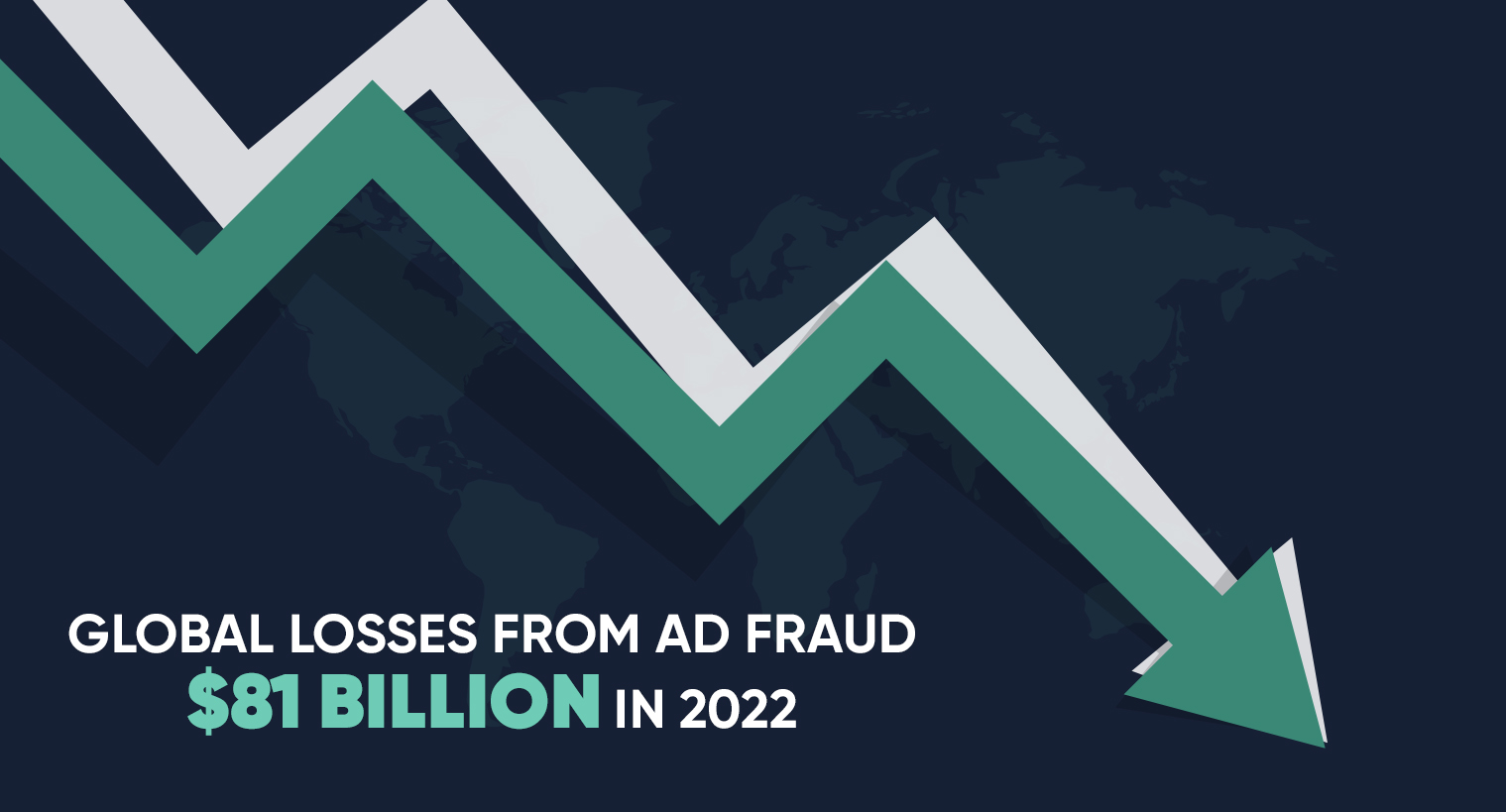How Digital Ad Fraud is Costing Advertisers Heavily? | 12 Apr, 2022

Is it possible to make more money without putting in any sweat, blood, or tears? With digital ad fraud, it is!
The rising digital advertising market is estimated to contribute 38% to the overall advertising industry in India in 2023. It is also estimated that the number of ad frauds will increase by 45-55%, as brands shift their ad budgets from conventional to digital.
According to reports, digital ad fraud is expected to cost brands around $81 billion in 2022. It also has the potential to reach up to 45% of overall ad spending.
Can you imagine the severity of digital ad fraud now?
Before we get into the details, let’s sort a few things out.
Understanding Digital Ad Fraud
Ad fraud is the act of deceiving advertising platforms into believing that the fake network activity (ad impressions, clicks, or conversions) is actual user behavior.
This is done by scammers with the motive of generating profits by giving fake promises to improve audience growth, engagement, and website traffic.
However, with brands losing billions of dollars every year, ad fraud is not something unexplored. The first digital ad fraud of pay per click was reported in 2001. The only change is that the scale at which it is now committed has increased drastically.
Newer and smaller businesses are more likely to fall prey to such traps because of their desire to improve website engagement and enhance their brand’s reach.
But who is responsible for these digital ad scams? What are the different kinds of ad scams that have occurred? How does it affect the operation of a business? Is there a method for businesses to protect themselves against it?
These are a few questions that advertisers/brands occasionally lookout for the answers to.
Who Commits Digital Ad Fraud?
An industry report states that every $1 out of $3 spent on online advertising by marketers is siphoned off by fraudsters.
There are three parasites who might be involved in committing digital ad fraud – an advertising company, publisher, or competitor.
The ad company may try to profit from the advertiser’s business through digital ad fraud. The goal of the fraudsters is to extract money without making a big deal out of it.
The brand’s competitors, on the other hand, commit digital ad fraud through their deceptive behavior by disrupting the marketing and general business operations, which might be disastrous for the company.
Finally, there are the publishers. They deceive the advertiser by using fake users, invalid traffic, and other methods. Publishers that engage in this practice might increase their fraudulent earnings by engaging in more malicious activities on the site. They can, for example, do this by placing 100 or 1,000 ad impressions on each page.
It is crucial for businesses to comprehend digital ad fraud and how criminals profit from it. As a result, they will be able to take preventative measures and avoid problems before they occur.
What are the Types of Digital Ad Fraud?
The most preferred method to conduct digital ad fraud is by using bots.
However, there are many other methods too, through which ad fraud can be implemented.
-
Domain Spoofing
Domain spoofing is a type of phishing that impersonates a high-quality domain website. Cybercriminals use this method to deceive marketers into paying more for advertising space on the fake website than they should.
This entails creating a false domain, or a string of them, that appears identical to a well-known domain with the same or similar name.
Some indicators of domain spoofing include traffic from the spoofed domain not matching with that of the real website, and cost per mille (CPM) being too low for a high-value site.
The domain in question is not normally running ads, the publisher is not selling ad space in real-time bidding (RTB) auctions, and a suspicious email is listed as the domain owner.
-
Click Injection
This is a method of ad fraud in which attackers install malware on user devices. The virus will then create clicks on advertisements, such as Facebook advertising or website banner ads, in order to exaggerate spending on those ads.
-
Cookie Stuffing
One of the most popular kinds of Ad Fraud is cookie stuffing. Cookie stuffing misleads and dilutes audience information. Thus, messing up the whole campaign’s results.
How does it work?
Affiliate marketing systems are one of the most common areas when cookie stuffing takes place.
Cookies are little text files that are stored in a computer browser. They help in tracking the user’s path from affiliate to central sites. A cookie exchange occurs when a person visits and clicks on an affiliate link.
Moreover, when a user visits the source site, the source site pays an affiliate. Cookie stuffing inflates numbers and forces the source site to spend more while gaining less.
-
Pixel Stuffing
Pixel stuffing is a type of ad fraud in which a fraudster builds a small advertising display, generally 1 x 1-pixel in size, that a normal person would never notice.
This deceptive ad strategy is intended to exploit marketing programs that rely on ad expenditure on impressions.
A criminal can use pixel stuffing to show dozens or even hundreds of adverts on a single webpage and receive credit for impressions. However, these single-pixel advertisements do not produce results since viewers are unaware that they “see” an ad.
-
Ad Stacking
The purpose of ad stacking is similar to that of pixel stuffing: to show more advertising to website visitors in order to increase impressions.
The difference between ad stacking and pixel stuffing is that instead of making “invisible” advertising that is only one pixel wide, numerous ads are “stacked” one on top of the other in the web browser.
For example, if five advertisements are piled on top of one another, the fraudster can claim credit for all five impressions, even though only the “top” ad is visible to website visitors. Because each ad might place a cookie on the visitor’s web browser, this can also contribute to cookie stuffing.
-
Ad Injection
Ad injection is a fraud tactic in which scammers employ browser extensions, plugins, and spyware to display advertisements where they should not show or replace advertisements on a website with new advertisements.
When users click on these misplaced adverts, the fraudster receives credit for a click – despite the fact that they do not control the website the person is visiting.
How can Digital Ad Fraud Affect a Company?
There are very serious implications of digital ad fraud on a company’s overall performance. Some of them are:
-
Advertisement Budget is Wasted
The worst consequence of ad fraud is that it eats advertising money and delivers no results.
Many types of ad fraud claim credit for coincidental site visits (cookie stuffing, pixel stuffing, and ad stacking), generate fake clicks and impressions or, artificially boost the cost of impressions or clicks on low-quality sites.
-
Time Wasted on Bad Leads.
To generate income fast and consistently, the sales staff must concentrate on generating high-quality leads. Ad fraud often produces low-quality or fake leads with no intention of conducting business.
This wastes a lot of time for the sales department. Salespeople may even lose out on legitimate, high-quality leads if they spend too much time pursuing low-quality leads from fraudulent sources.
-
Brand’s Reputation is at Stake
Being linked to ad injection fraud can harm a company’s reputation in the long run. Ads that run on sites are inappropriate for the brand and can also harm the business’s image.
-
Legal Expenses
Recovering money from scammers is a time-consuming and tough task. Moreover, bringing a case against a person or entity that has committed fraud requires considerable legal help.
How can Advertisers Protect themselves from Digital Ad Fraud?
How many times have you become a victim of digital ad fraud?
To ensure all the advertisement initiatives are effective, marketers must confirm that their ad spend is reaching the targeted audience.
This is possible with Mirrors by Silverpush.
Mirrors’ in-video context detection technology recognizes scenes, people, logos, objects, and activities in a streaming video. This helps filter the most relevant video content specifically tailored for each campaign and targeted audience, and also ensures brand safety.

BLOGS
Crafting a Winning Mother’s Day Advertising Strategy for 2024: Insights and Trends
As we approach Mother’s Day 2024, brands must prepare to adapt to changing consumer needs and preferences. Considering the current market dynamics and consumer behavior, it's crucial to develop a successful Mother’s Day campaign that extends beyond the day itself. Here's a detailed roadmap to navigating the Mother’s Day market, ...

BLOGS
Win Gold for Summer Olympics 2024 with AI-Powered Video Ads
The Paris Olympic Games 2024 is not merely a gathering of the world’s finest athletes, but it’s a testament to unity, diversity, and the pinnacle of human excellence. The grand spectacle sparks surges in consumer engagement and purchase intent worldwide. Whether you operate shoe boutiques in Ohio, bicycle repair shops ...

BLOGS
Interactive Video Ads: Turn Passive Viewers to Active Participants
Interactive video ads signify a revolutionary change in digital advertising, turning passive spectators into dynamic participants. Through the smooth integration of interactive elements such as touchpoints, quizzes, and clickable features, these ads present an unparalleled avenue for brands to connect with their audience. Viewers are no longer just observers but ...











